Literature Review: Challenges Faced by Businesses in Cyber Security
VerifiedAdded on 2020/06/06
|9
|3490
|73
Literature Review
AI Summary
This literature review examines the challenges businesses face in implementing cyber security. It begins by defining cyber security and its importance in protecting vital data and information from threats like malware and hacking. The review explores the increasing risks associated with the growth of data, cloud computing, and remote systems. It highlights various challenges, including malware attacks, ransomware, internal threats, and the constant evolution of security risks. The review analyzes how businesses are impacted by cyber attacks, including financial and reputational damages, and the need for frequent security upgrades. It discusses the importance of investing in cyber security measures, employee monitoring, and purchasing security systems from certified organizations. The review concludes by emphasizing the ongoing efforts of management and IT experts to improve security in the face of evolving cyber threats.
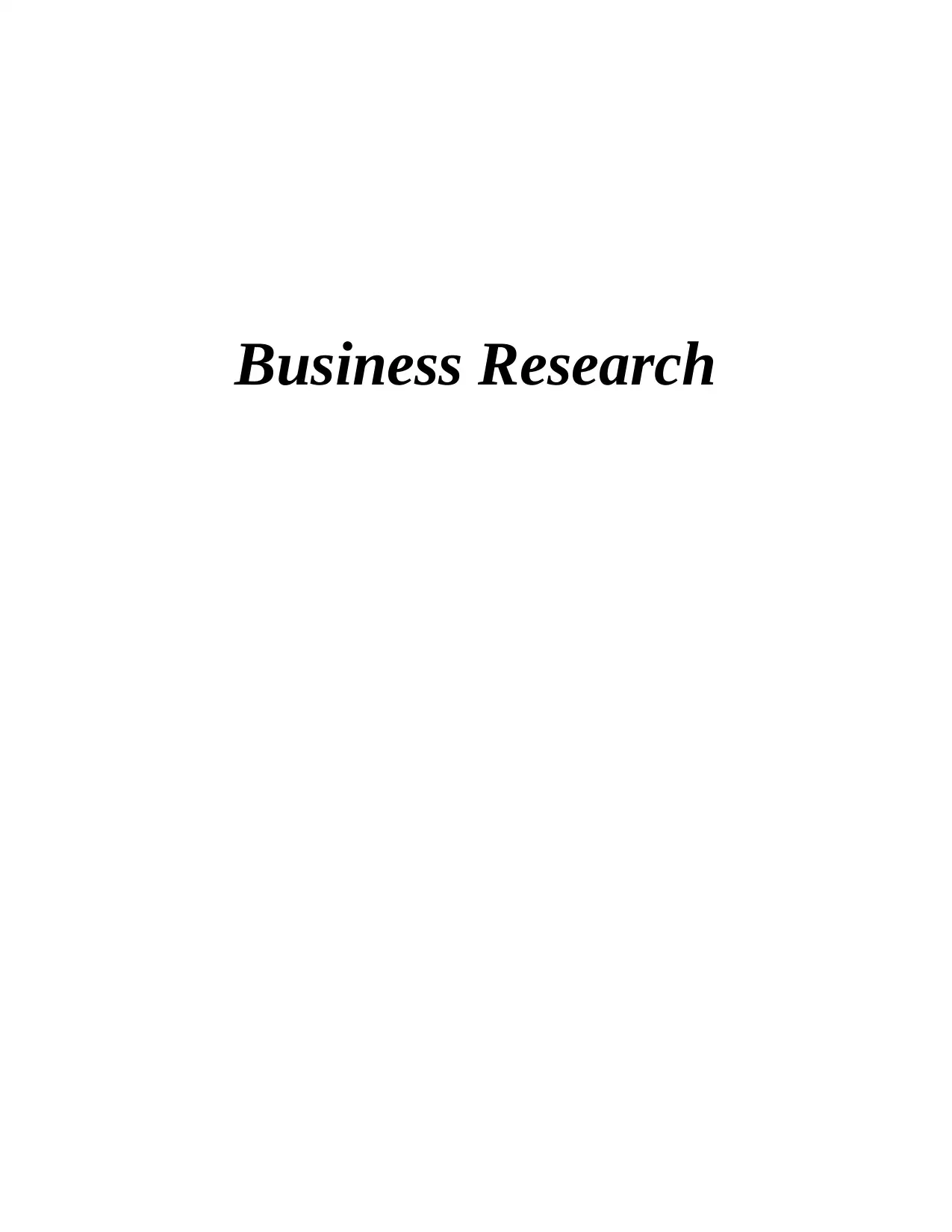
Business Research
Paraphrase This Document
Need a fresh take? Get an instant paraphrase of this document with our AI Paraphraser
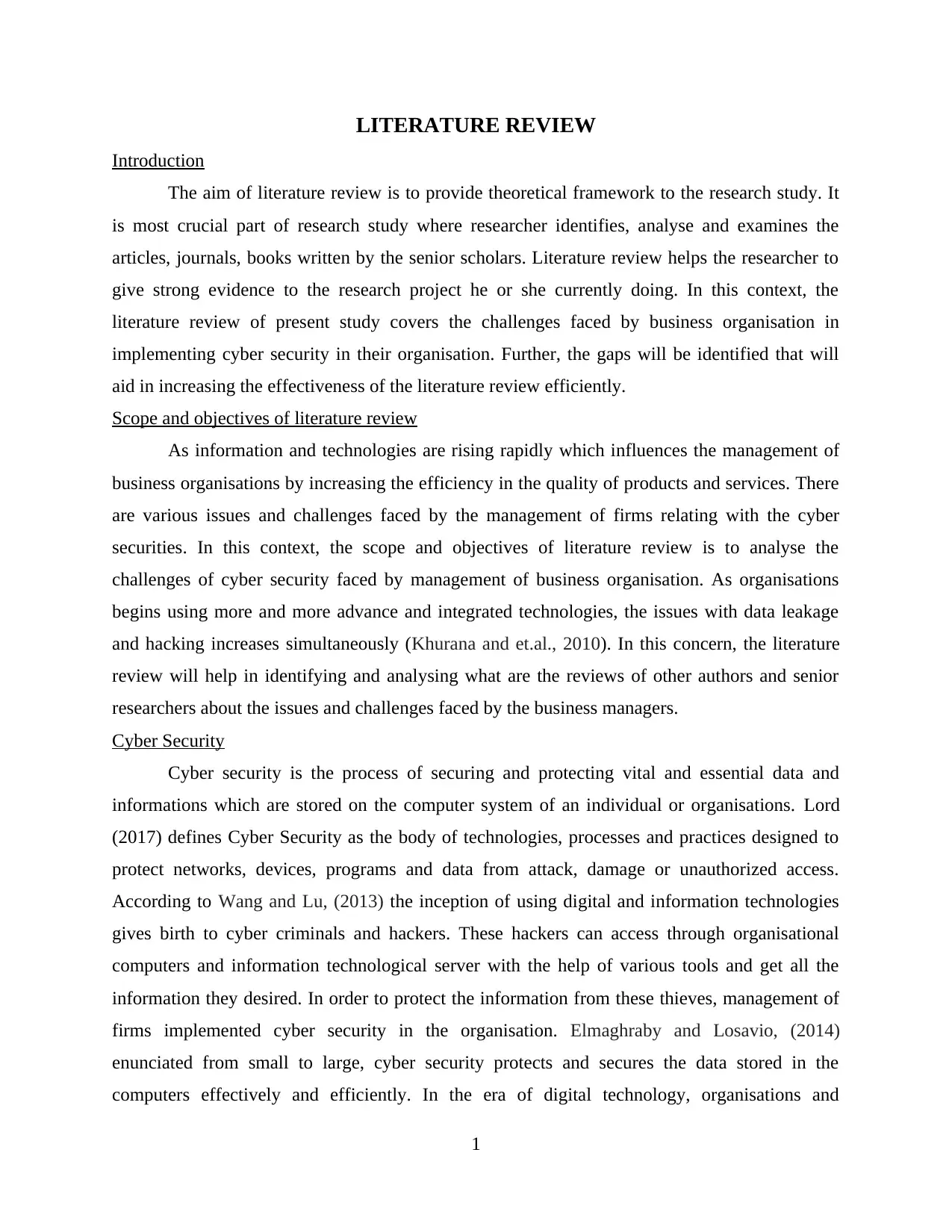
LITERATURE REVIEW
Introduction
The aim of literature review is to provide theoretical framework to the research study. It
is most crucial part of research study where researcher identifies, analyse and examines the
articles, journals, books written by the senior scholars. Literature review helps the researcher to
give strong evidence to the research project he or she currently doing. In this context, the
literature review of present study covers the challenges faced by business organisation in
implementing cyber security in their organisation. Further, the gaps will be identified that will
aid in increasing the effectiveness of the literature review efficiently.
Scope and objectives of literature review
As information and technologies are rising rapidly which influences the management of
business organisations by increasing the efficiency in the quality of products and services. There
are various issues and challenges faced by the management of firms relating with the cyber
securities. In this context, the scope and objectives of literature review is to analyse the
challenges of cyber security faced by management of business organisation. As organisations
begins using more and more advance and integrated technologies, the issues with data leakage
and hacking increases simultaneously (Khurana and et.al., 2010). In this concern, the literature
review will help in identifying and analysing what are the reviews of other authors and senior
researchers about the issues and challenges faced by the business managers.
Cyber Security
Cyber security is the process of securing and protecting vital and essential data and
informations which are stored on the computer system of an individual or organisations. Lord
(2017) defines Cyber Security as the body of technologies, processes and practices designed to
protect networks, devices, programs and data from attack, damage or unauthorized access.
According to Wang and Lu, (2013) the inception of using digital and information technologies
gives birth to cyber criminals and hackers. These hackers can access through organisational
computers and information technological server with the help of various tools and get all the
information they desired. In order to protect the information from these thieves, management of
firms implemented cyber security in the organisation. Elmaghraby and Losavio, (2014)
enunciated from small to large, cyber security protects and secures the data stored in the
computers effectively and efficiently. In the era of digital technology, organisations and
1
Introduction
The aim of literature review is to provide theoretical framework to the research study. It
is most crucial part of research study where researcher identifies, analyse and examines the
articles, journals, books written by the senior scholars. Literature review helps the researcher to
give strong evidence to the research project he or she currently doing. In this context, the
literature review of present study covers the challenges faced by business organisation in
implementing cyber security in their organisation. Further, the gaps will be identified that will
aid in increasing the effectiveness of the literature review efficiently.
Scope and objectives of literature review
As information and technologies are rising rapidly which influences the management of
business organisations by increasing the efficiency in the quality of products and services. There
are various issues and challenges faced by the management of firms relating with the cyber
securities. In this context, the scope and objectives of literature review is to analyse the
challenges of cyber security faced by management of business organisation. As organisations
begins using more and more advance and integrated technologies, the issues with data leakage
and hacking increases simultaneously (Khurana and et.al., 2010). In this concern, the literature
review will help in identifying and analysing what are the reviews of other authors and senior
researchers about the issues and challenges faced by the business managers.
Cyber Security
Cyber security is the process of securing and protecting vital and essential data and
informations which are stored on the computer system of an individual or organisations. Lord
(2017) defines Cyber Security as the body of technologies, processes and practices designed to
protect networks, devices, programs and data from attack, damage or unauthorized access.
According to Wang and Lu, (2013) the inception of using digital and information technologies
gives birth to cyber criminals and hackers. These hackers can access through organisational
computers and information technological server with the help of various tools and get all the
information they desired. In order to protect the information from these thieves, management of
firms implemented cyber security in the organisation. Elmaghraby and Losavio, (2014)
enunciated from small to large, cyber security protects and secures the data stored in the
computers effectively and efficiently. In the era of digital technology, organisations and
1
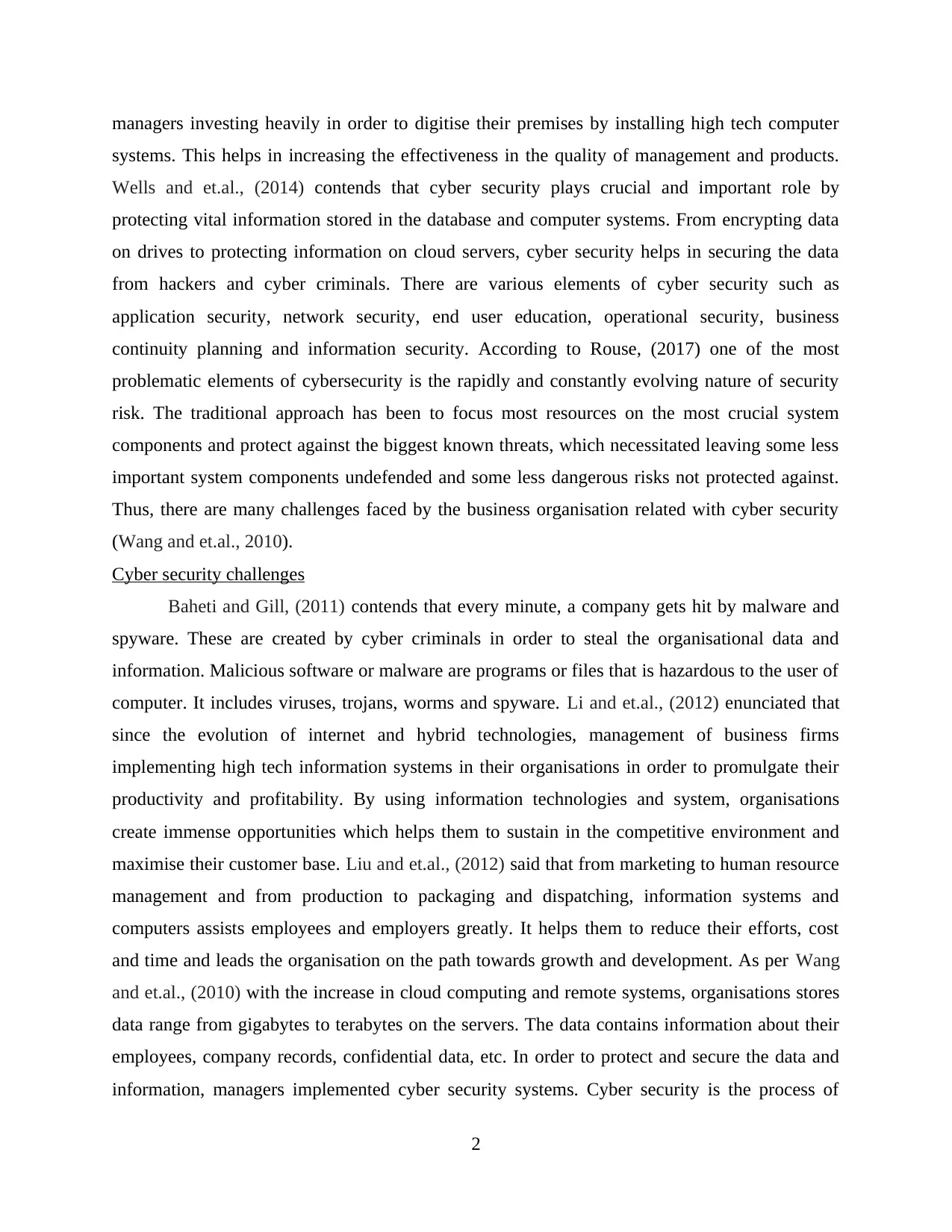
managers investing heavily in order to digitise their premises by installing high tech computer
systems. This helps in increasing the effectiveness in the quality of management and products.
Wells and et.al., (2014) contends that cyber security plays crucial and important role by
protecting vital information stored in the database and computer systems. From encrypting data
on drives to protecting information on cloud servers, cyber security helps in securing the data
from hackers and cyber criminals. There are various elements of cyber security such as
application security, network security, end user education, operational security, business
continuity planning and information security. According to Rouse, (2017) one of the most
problematic elements of cybersecurity is the rapidly and constantly evolving nature of security
risk. The traditional approach has been to focus most resources on the most crucial system
components and protect against the biggest known threats, which necessitated leaving some less
important system components undefended and some less dangerous risks not protected against.
Thus, there are many challenges faced by the business organisation related with cyber security
(Wang and et.al., 2010).
Cyber security challenges
Baheti and Gill, (2011) contends that every minute, a company gets hit by malware and
spyware. These are created by cyber criminals in order to steal the organisational data and
information. Malicious software or malware are programs or files that is hazardous to the user of
computer. It includes viruses, trojans, worms and spyware. Li and et.al., (2012) enunciated that
since the evolution of internet and hybrid technologies, management of business firms
implementing high tech information systems in their organisations in order to promulgate their
productivity and profitability. By using information technologies and system, organisations
create immense opportunities which helps them to sustain in the competitive environment and
maximise their customer base. Liu and et.al., (2012) said that from marketing to human resource
management and from production to packaging and dispatching, information systems and
computers assists employees and employers greatly. It helps them to reduce their efforts, cost
and time and leads the organisation on the path towards growth and development. As per Wang
and et.al., (2010) with the increase in cloud computing and remote systems, organisations stores
data range from gigabytes to terabytes on the servers. The data contains information about their
employees, company records, confidential data, etc. In order to protect and secure the data and
information, managers implemented cyber security systems. Cyber security is the process of
2
systems. This helps in increasing the effectiveness in the quality of management and products.
Wells and et.al., (2014) contends that cyber security plays crucial and important role by
protecting vital information stored in the database and computer systems. From encrypting data
on drives to protecting information on cloud servers, cyber security helps in securing the data
from hackers and cyber criminals. There are various elements of cyber security such as
application security, network security, end user education, operational security, business
continuity planning and information security. According to Rouse, (2017) one of the most
problematic elements of cybersecurity is the rapidly and constantly evolving nature of security
risk. The traditional approach has been to focus most resources on the most crucial system
components and protect against the biggest known threats, which necessitated leaving some less
important system components undefended and some less dangerous risks not protected against.
Thus, there are many challenges faced by the business organisation related with cyber security
(Wang and et.al., 2010).
Cyber security challenges
Baheti and Gill, (2011) contends that every minute, a company gets hit by malware and
spyware. These are created by cyber criminals in order to steal the organisational data and
information. Malicious software or malware are programs or files that is hazardous to the user of
computer. It includes viruses, trojans, worms and spyware. Li and et.al., (2012) enunciated that
since the evolution of internet and hybrid technologies, management of business firms
implementing high tech information systems in their organisations in order to promulgate their
productivity and profitability. By using information technologies and system, organisations
create immense opportunities which helps them to sustain in the competitive environment and
maximise their customer base. Liu and et.al., (2012) said that from marketing to human resource
management and from production to packaging and dispatching, information systems and
computers assists employees and employers greatly. It helps them to reduce their efforts, cost
and time and leads the organisation on the path towards growth and development. As per Wang
and et.al., (2010) with the increase in cloud computing and remote systems, organisations stores
data range from gigabytes to terabytes on the servers. The data contains information about their
employees, company records, confidential data, etc. In order to protect and secure the data and
information, managers implemented cyber security systems. Cyber security is the process of
2
⊘ This is a preview!⊘
Do you want full access?
Subscribe today to unlock all pages.

Trusted by 1+ million students worldwide
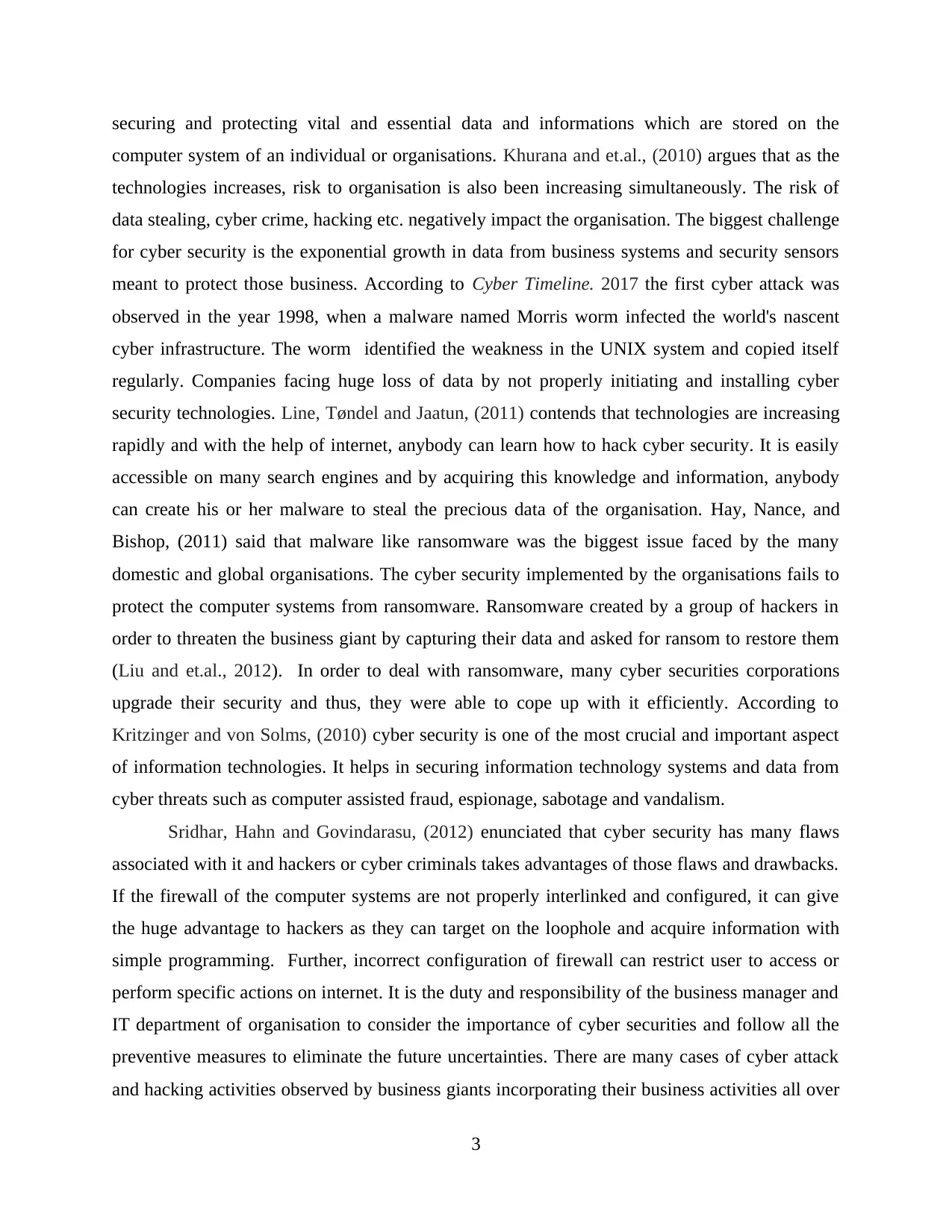
securing and protecting vital and essential data and informations which are stored on the
computer system of an individual or organisations. Khurana and et.al., (2010) argues that as the
technologies increases, risk to organisation is also been increasing simultaneously. The risk of
data stealing, cyber crime, hacking etc. negatively impact the organisation. The biggest challenge
for cyber security is the exponential growth in data from business systems and security sensors
meant to protect those business. According to Cyber Timeline. 2017 the first cyber attack was
observed in the year 1998, when a malware named Morris worm infected the world's nascent
cyber infrastructure. The worm identified the weakness in the UNIX system and copied itself
regularly. Companies facing huge loss of data by not properly initiating and installing cyber
security technologies. Line, Tøndel and Jaatun, (2011) contends that technologies are increasing
rapidly and with the help of internet, anybody can learn how to hack cyber security. It is easily
accessible on many search engines and by acquiring this knowledge and information, anybody
can create his or her malware to steal the precious data of the organisation. Hay, Nance, and
Bishop, (2011) said that malware like ransomware was the biggest issue faced by the many
domestic and global organisations. The cyber security implemented by the organisations fails to
protect the computer systems from ransomware. Ransomware created by a group of hackers in
order to threaten the business giant by capturing their data and asked for ransom to restore them
(Liu and et.al., 2012). In order to deal with ransomware, many cyber securities corporations
upgrade their security and thus, they were able to cope up with it efficiently. According to
Kritzinger and von Solms, (2010) cyber security is one of the most crucial and important aspect
of information technologies. It helps in securing information technology systems and data from
cyber threats such as computer assisted fraud, espionage, sabotage and vandalism.
Sridhar, Hahn and Govindarasu, (2012) enunciated that cyber security has many flaws
associated with it and hackers or cyber criminals takes advantages of those flaws and drawbacks.
If the firewall of the computer systems are not properly interlinked and configured, it can give
the huge advantage to hackers as they can target on the loophole and acquire information with
simple programming. Further, incorrect configuration of firewall can restrict user to access or
perform specific actions on internet. It is the duty and responsibility of the business manager and
IT department of organisation to consider the importance of cyber securities and follow all the
preventive measures to eliminate the future uncertainties. There are many cases of cyber attack
and hacking activities observed by business giants incorporating their business activities all over
3
computer system of an individual or organisations. Khurana and et.al., (2010) argues that as the
technologies increases, risk to organisation is also been increasing simultaneously. The risk of
data stealing, cyber crime, hacking etc. negatively impact the organisation. The biggest challenge
for cyber security is the exponential growth in data from business systems and security sensors
meant to protect those business. According to Cyber Timeline. 2017 the first cyber attack was
observed in the year 1998, when a malware named Morris worm infected the world's nascent
cyber infrastructure. The worm identified the weakness in the UNIX system and copied itself
regularly. Companies facing huge loss of data by not properly initiating and installing cyber
security technologies. Line, Tøndel and Jaatun, (2011) contends that technologies are increasing
rapidly and with the help of internet, anybody can learn how to hack cyber security. It is easily
accessible on many search engines and by acquiring this knowledge and information, anybody
can create his or her malware to steal the precious data of the organisation. Hay, Nance, and
Bishop, (2011) said that malware like ransomware was the biggest issue faced by the many
domestic and global organisations. The cyber security implemented by the organisations fails to
protect the computer systems from ransomware. Ransomware created by a group of hackers in
order to threaten the business giant by capturing their data and asked for ransom to restore them
(Liu and et.al., 2012). In order to deal with ransomware, many cyber securities corporations
upgrade their security and thus, they were able to cope up with it efficiently. According to
Kritzinger and von Solms, (2010) cyber security is one of the most crucial and important aspect
of information technologies. It helps in securing information technology systems and data from
cyber threats such as computer assisted fraud, espionage, sabotage and vandalism.
Sridhar, Hahn and Govindarasu, (2012) enunciated that cyber security has many flaws
associated with it and hackers or cyber criminals takes advantages of those flaws and drawbacks.
If the firewall of the computer systems are not properly interlinked and configured, it can give
the huge advantage to hackers as they can target on the loophole and acquire information with
simple programming. Further, incorrect configuration of firewall can restrict user to access or
perform specific actions on internet. It is the duty and responsibility of the business manager and
IT department of organisation to consider the importance of cyber securities and follow all the
preventive measures to eliminate the future uncertainties. There are many cases of cyber attack
and hacking activities observed by business giants incorporating their business activities all over
3
Paraphrase This Document
Need a fresh take? Get an instant paraphrase of this document with our AI Paraphraser
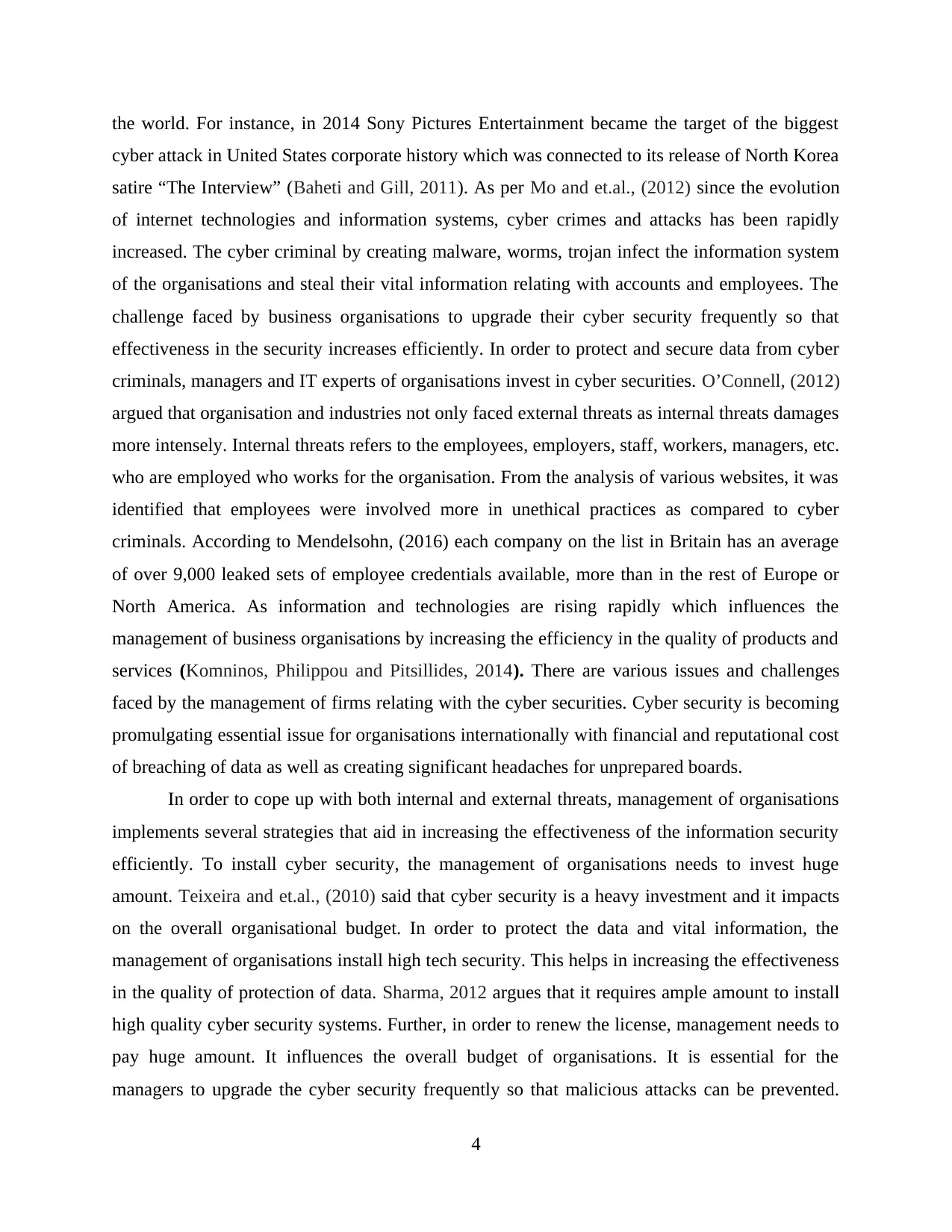
the world. For instance, in 2014 Sony Pictures Entertainment became the target of the biggest
cyber attack in United States corporate history which was connected to its release of North Korea
satire “The Interview” (Baheti and Gill, 2011). As per Mo and et.al., (2012) since the evolution
of internet technologies and information systems, cyber crimes and attacks has been rapidly
increased. The cyber criminal by creating malware, worms, trojan infect the information system
of the organisations and steal their vital information relating with accounts and employees. The
challenge faced by business organisations to upgrade their cyber security frequently so that
effectiveness in the security increases efficiently. In order to protect and secure data from cyber
criminals, managers and IT experts of organisations invest in cyber securities. O’Connell, (2012)
argued that organisation and industries not only faced external threats as internal threats damages
more intensely. Internal threats refers to the employees, employers, staff, workers, managers, etc.
who are employed who works for the organisation. From the analysis of various websites, it was
identified that employees were involved more in unethical practices as compared to cyber
criminals. According to Mendelsohn, (2016) each company on the list in Britain has an average
of over 9,000 leaked sets of employee credentials available, more than in the rest of Europe or
North America. As information and technologies are rising rapidly which influences the
management of business organisations by increasing the efficiency in the quality of products and
services (Komninos, Philippou and Pitsillides, 2014). There are various issues and challenges
faced by the management of firms relating with the cyber securities. Cyber security is becoming
promulgating essential issue for organisations internationally with financial and reputational cost
of breaching of data as well as creating significant headaches for unprepared boards.
In order to cope up with both internal and external threats, management of organisations
implements several strategies that aid in increasing the effectiveness of the information security
efficiently. To install cyber security, the management of organisations needs to invest huge
amount. Teixeira and et.al., (2010) said that cyber security is a heavy investment and it impacts
on the overall organisational budget. In order to protect the data and vital information, the
management of organisations install high tech security. This helps in increasing the effectiveness
in the quality of protection of data. Sharma, 2012 argues that it requires ample amount to install
high quality cyber security systems. Further, in order to renew the license, management needs to
pay huge amount. It influences the overall budget of organisations. It is essential for the
managers to upgrade the cyber security frequently so that malicious attacks can be prevented.
4
cyber attack in United States corporate history which was connected to its release of North Korea
satire “The Interview” (Baheti and Gill, 2011). As per Mo and et.al., (2012) since the evolution
of internet technologies and information systems, cyber crimes and attacks has been rapidly
increased. The cyber criminal by creating malware, worms, trojan infect the information system
of the organisations and steal their vital information relating with accounts and employees. The
challenge faced by business organisations to upgrade their cyber security frequently so that
effectiveness in the security increases efficiently. In order to protect and secure data from cyber
criminals, managers and IT experts of organisations invest in cyber securities. O’Connell, (2012)
argued that organisation and industries not only faced external threats as internal threats damages
more intensely. Internal threats refers to the employees, employers, staff, workers, managers, etc.
who are employed who works for the organisation. From the analysis of various websites, it was
identified that employees were involved more in unethical practices as compared to cyber
criminals. According to Mendelsohn, (2016) each company on the list in Britain has an average
of over 9,000 leaked sets of employee credentials available, more than in the rest of Europe or
North America. As information and technologies are rising rapidly which influences the
management of business organisations by increasing the efficiency in the quality of products and
services (Komninos, Philippou and Pitsillides, 2014). There are various issues and challenges
faced by the management of firms relating with the cyber securities. Cyber security is becoming
promulgating essential issue for organisations internationally with financial and reputational cost
of breaching of data as well as creating significant headaches for unprepared boards.
In order to cope up with both internal and external threats, management of organisations
implements several strategies that aid in increasing the effectiveness of the information security
efficiently. To install cyber security, the management of organisations needs to invest huge
amount. Teixeira and et.al., (2010) said that cyber security is a heavy investment and it impacts
on the overall organisational budget. In order to protect the data and vital information, the
management of organisations install high tech security. This helps in increasing the effectiveness
in the quality of protection of data. Sharma, 2012 argues that it requires ample amount to install
high quality cyber security systems. Further, in order to renew the license, management needs to
pay huge amount. It influences the overall budget of organisations. It is essential for the
managers to upgrade the cyber security frequently so that malicious attacks can be prevented.
4
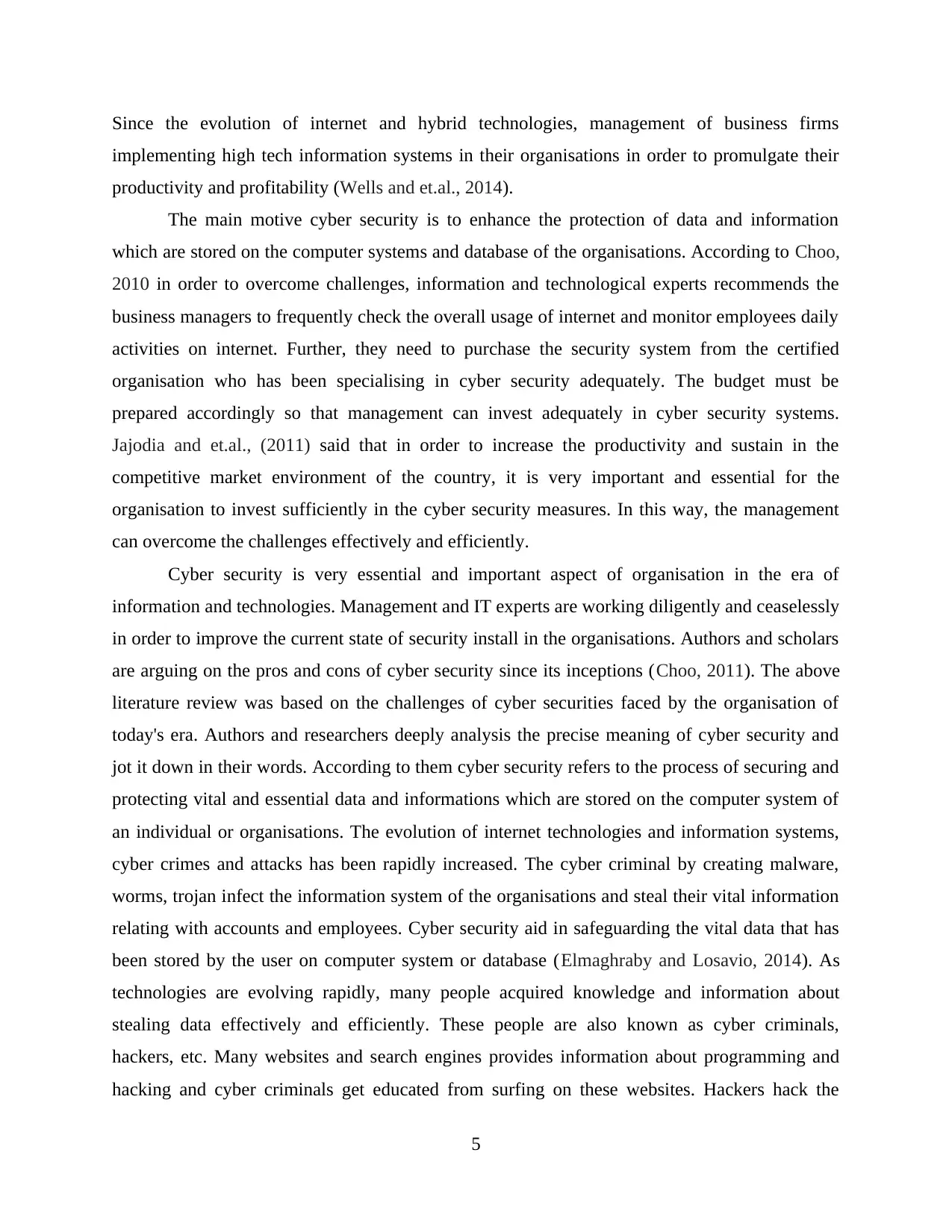
Since the evolution of internet and hybrid technologies, management of business firms
implementing high tech information systems in their organisations in order to promulgate their
productivity and profitability (Wells and et.al., 2014).
The main motive cyber security is to enhance the protection of data and information
which are stored on the computer systems and database of the organisations. According to Choo,
2010 in order to overcome challenges, information and technological experts recommends the
business managers to frequently check the overall usage of internet and monitor employees daily
activities on internet. Further, they need to purchase the security system from the certified
organisation who has been specialising in cyber security adequately. The budget must be
prepared accordingly so that management can invest adequately in cyber security systems.
Jajodia and et.al., (2011) said that in order to increase the productivity and sustain in the
competitive market environment of the country, it is very important and essential for the
organisation to invest sufficiently in the cyber security measures. In this way, the management
can overcome the challenges effectively and efficiently.
Cyber security is very essential and important aspect of organisation in the era of
information and technologies. Management and IT experts are working diligently and ceaselessly
in order to improve the current state of security install in the organisations. Authors and scholars
are arguing on the pros and cons of cyber security since its inceptions (Choo, 2011). The above
literature review was based on the challenges of cyber securities faced by the organisation of
today's era. Authors and researchers deeply analysis the precise meaning of cyber security and
jot it down in their words. According to them cyber security refers to the process of securing and
protecting vital and essential data and informations which are stored on the computer system of
an individual or organisations. The evolution of internet technologies and information systems,
cyber crimes and attacks has been rapidly increased. The cyber criminal by creating malware,
worms, trojan infect the information system of the organisations and steal their vital information
relating with accounts and employees. Cyber security aid in safeguarding the vital data that has
been stored by the user on computer system or database (Elmaghraby and Losavio, 2014). As
technologies are evolving rapidly, many people acquired knowledge and information about
stealing data effectively and efficiently. These people are also known as cyber criminals,
hackers, etc. Many websites and search engines provides information about programming and
hacking and cyber criminals get educated from surfing on these websites. Hackers hack the
5
implementing high tech information systems in their organisations in order to promulgate their
productivity and profitability (Wells and et.al., 2014).
The main motive cyber security is to enhance the protection of data and information
which are stored on the computer systems and database of the organisations. According to Choo,
2010 in order to overcome challenges, information and technological experts recommends the
business managers to frequently check the overall usage of internet and monitor employees daily
activities on internet. Further, they need to purchase the security system from the certified
organisation who has been specialising in cyber security adequately. The budget must be
prepared accordingly so that management can invest adequately in cyber security systems.
Jajodia and et.al., (2011) said that in order to increase the productivity and sustain in the
competitive market environment of the country, it is very important and essential for the
organisation to invest sufficiently in the cyber security measures. In this way, the management
can overcome the challenges effectively and efficiently.
Cyber security is very essential and important aspect of organisation in the era of
information and technologies. Management and IT experts are working diligently and ceaselessly
in order to improve the current state of security install in the organisations. Authors and scholars
are arguing on the pros and cons of cyber security since its inceptions (Choo, 2011). The above
literature review was based on the challenges of cyber securities faced by the organisation of
today's era. Authors and researchers deeply analysis the precise meaning of cyber security and
jot it down in their words. According to them cyber security refers to the process of securing and
protecting vital and essential data and informations which are stored on the computer system of
an individual or organisations. The evolution of internet technologies and information systems,
cyber crimes and attacks has been rapidly increased. The cyber criminal by creating malware,
worms, trojan infect the information system of the organisations and steal their vital information
relating with accounts and employees. Cyber security aid in safeguarding the vital data that has
been stored by the user on computer system or database (Elmaghraby and Losavio, 2014). As
technologies are evolving rapidly, many people acquired knowledge and information about
stealing data effectively and efficiently. These people are also known as cyber criminals,
hackers, etc. Many websites and search engines provides information about programming and
hacking and cyber criminals get educated from surfing on these websites. Hackers hack the
5
⊘ This is a preview!⊘
Do you want full access?
Subscribe today to unlock all pages.

Trusted by 1+ million students worldwide
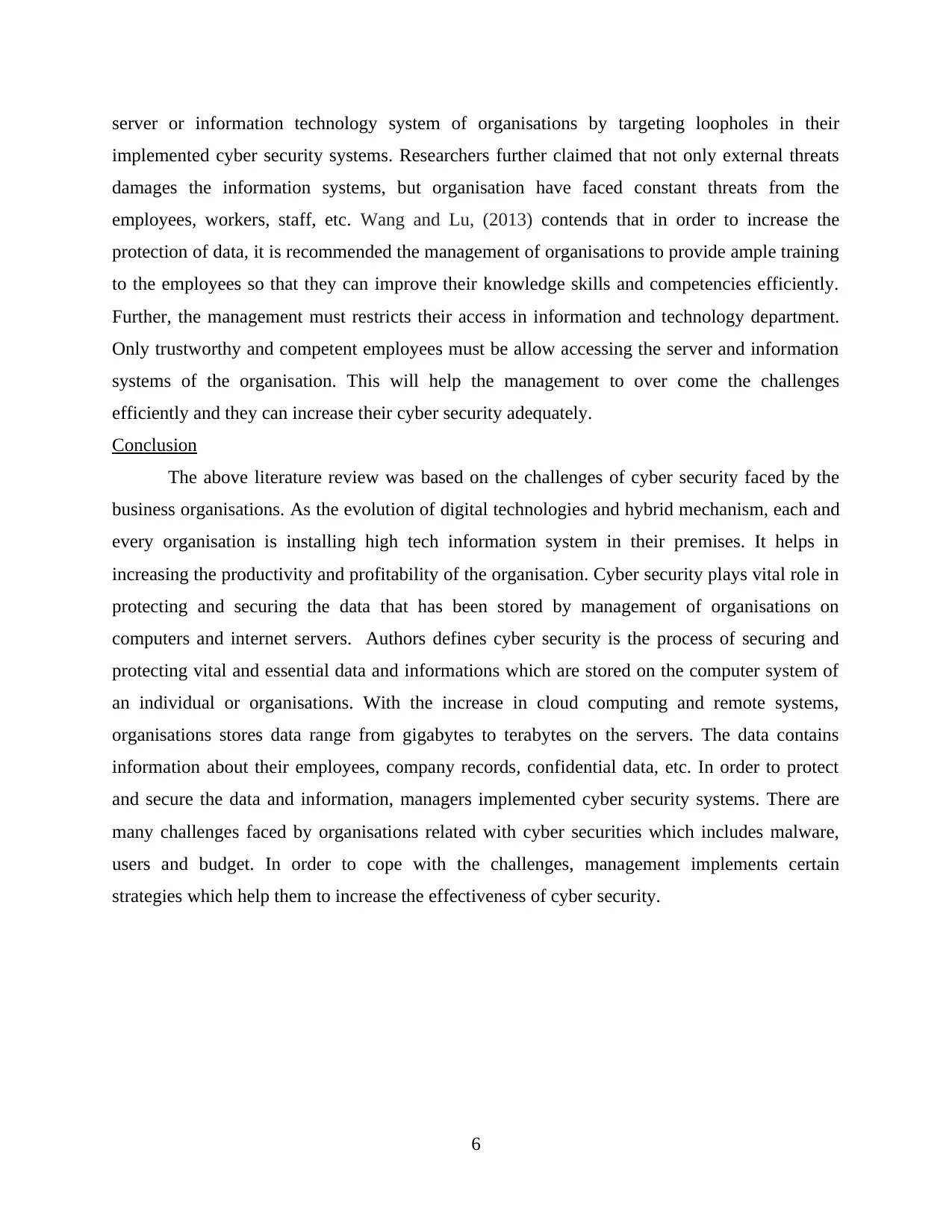
server or information technology system of organisations by targeting loopholes in their
implemented cyber security systems. Researchers further claimed that not only external threats
damages the information systems, but organisation have faced constant threats from the
employees, workers, staff, etc. Wang and Lu, (2013) contends that in order to increase the
protection of data, it is recommended the management of organisations to provide ample training
to the employees so that they can improve their knowledge skills and competencies efficiently.
Further, the management must restricts their access in information and technology department.
Only trustworthy and competent employees must be allow accessing the server and information
systems of the organisation. This will help the management to over come the challenges
efficiently and they can increase their cyber security adequately.
Conclusion
The above literature review was based on the challenges of cyber security faced by the
business organisations. As the evolution of digital technologies and hybrid mechanism, each and
every organisation is installing high tech information system in their premises. It helps in
increasing the productivity and profitability of the organisation. Cyber security plays vital role in
protecting and securing the data that has been stored by management of organisations on
computers and internet servers. Authors defines cyber security is the process of securing and
protecting vital and essential data and informations which are stored on the computer system of
an individual or organisations. With the increase in cloud computing and remote systems,
organisations stores data range from gigabytes to terabytes on the servers. The data contains
information about their employees, company records, confidential data, etc. In order to protect
and secure the data and information, managers implemented cyber security systems. There are
many challenges faced by organisations related with cyber securities which includes malware,
users and budget. In order to cope with the challenges, management implements certain
strategies which help them to increase the effectiveness of cyber security.
6
implemented cyber security systems. Researchers further claimed that not only external threats
damages the information systems, but organisation have faced constant threats from the
employees, workers, staff, etc. Wang and Lu, (2013) contends that in order to increase the
protection of data, it is recommended the management of organisations to provide ample training
to the employees so that they can improve their knowledge skills and competencies efficiently.
Further, the management must restricts their access in information and technology department.
Only trustworthy and competent employees must be allow accessing the server and information
systems of the organisation. This will help the management to over come the challenges
efficiently and they can increase their cyber security adequately.
Conclusion
The above literature review was based on the challenges of cyber security faced by the
business organisations. As the evolution of digital technologies and hybrid mechanism, each and
every organisation is installing high tech information system in their premises. It helps in
increasing the productivity and profitability of the organisation. Cyber security plays vital role in
protecting and securing the data that has been stored by management of organisations on
computers and internet servers. Authors defines cyber security is the process of securing and
protecting vital and essential data and informations which are stored on the computer system of
an individual or organisations. With the increase in cloud computing and remote systems,
organisations stores data range from gigabytes to terabytes on the servers. The data contains
information about their employees, company records, confidential data, etc. In order to protect
and secure the data and information, managers implemented cyber security systems. There are
many challenges faced by organisations related with cyber securities which includes malware,
users and budget. In order to cope with the challenges, management implements certain
strategies which help them to increase the effectiveness of cyber security.
6
Paraphrase This Document
Need a fresh take? Get an instant paraphrase of this document with our AI Paraphraser
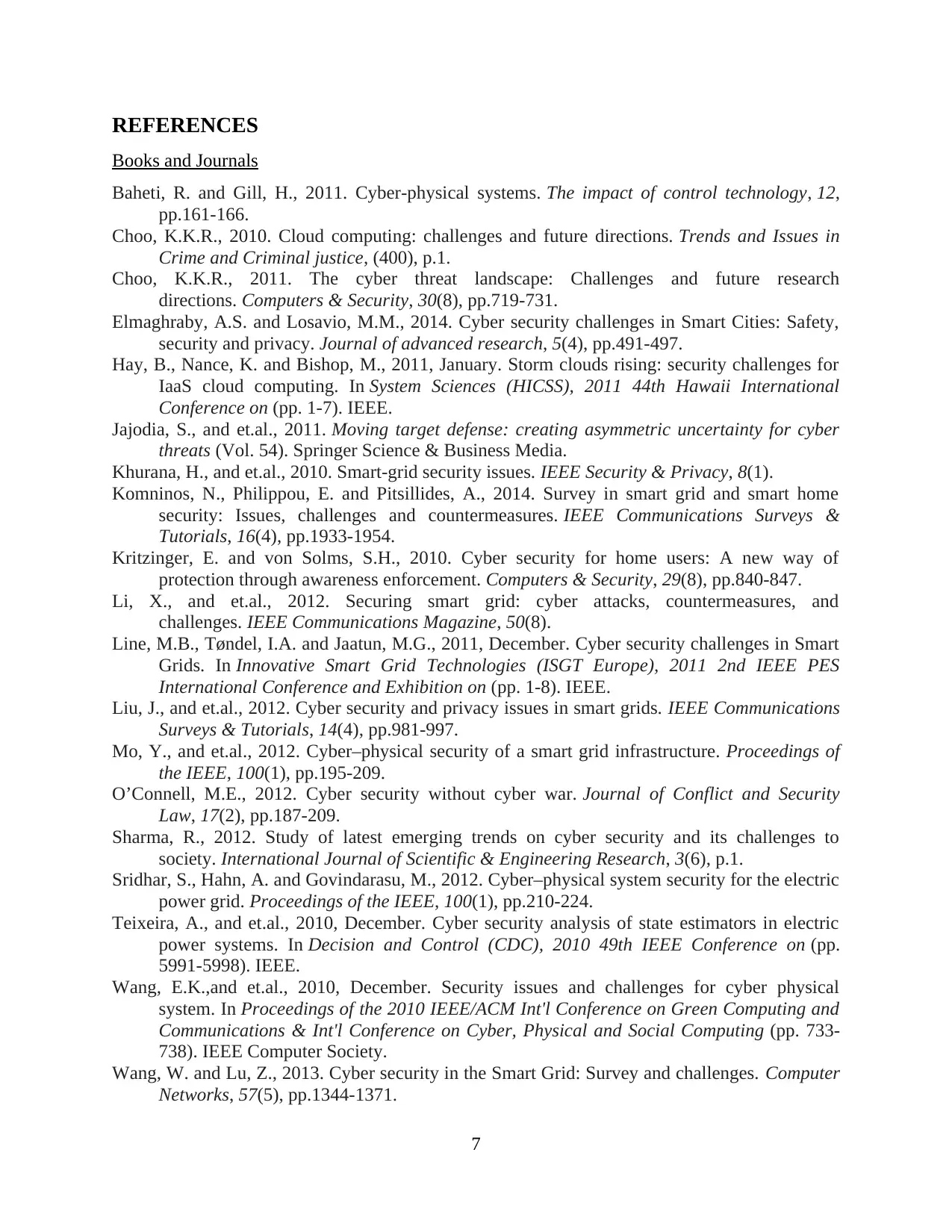
REFERENCES
Books and Journals
Baheti, R. and Gill, H., 2011. Cyber-physical systems. The impact of control technology, 12,
pp.161-166.
Choo, K.K.R., 2010. Cloud computing: challenges and future directions. Trends and Issues in
Crime and Criminal justice, (400), p.1.
Choo, K.K.R., 2011. The cyber threat landscape: Challenges and future research
directions. Computers & Security, 30(8), pp.719-731.
Elmaghraby, A.S. and Losavio, M.M., 2014. Cyber security challenges in Smart Cities: Safety,
security and privacy. Journal of advanced research, 5(4), pp.491-497.
Hay, B., Nance, K. and Bishop, M., 2011, January. Storm clouds rising: security challenges for
IaaS cloud computing. In System Sciences (HICSS), 2011 44th Hawaii International
Conference on (pp. 1-7). IEEE.
Jajodia, S., and et.al., 2011. Moving target defense: creating asymmetric uncertainty for cyber
threats (Vol. 54). Springer Science & Business Media.
Khurana, H., and et.al., 2010. Smart-grid security issues. IEEE Security & Privacy, 8(1).
Komninos, N., Philippou, E. and Pitsillides, A., 2014. Survey in smart grid and smart home
security: Issues, challenges and countermeasures. IEEE Communications Surveys &
Tutorials, 16(4), pp.1933-1954.
Kritzinger, E. and von Solms, S.H., 2010. Cyber security for home users: A new way of
protection through awareness enforcement. Computers & Security, 29(8), pp.840-847.
Li, X., and et.al., 2012. Securing smart grid: cyber attacks, countermeasures, and
challenges. IEEE Communications Magazine, 50(8).
Line, M.B., Tøndel, I.A. and Jaatun, M.G., 2011, December. Cyber security challenges in Smart
Grids. In Innovative Smart Grid Technologies (ISGT Europe), 2011 2nd IEEE PES
International Conference and Exhibition on (pp. 1-8). IEEE.
Liu, J., and et.al., 2012. Cyber security and privacy issues in smart grids. IEEE Communications
Surveys & Tutorials, 14(4), pp.981-997.
Mo, Y., and et.al., 2012. Cyber–physical security of a smart grid infrastructure. Proceedings of
the IEEE, 100(1), pp.195-209.
O’Connell, M.E., 2012. Cyber security without cyber war. Journal of Conflict and Security
Law, 17(2), pp.187-209.
Sharma, R., 2012. Study of latest emerging trends on cyber security and its challenges to
society. International Journal of Scientific & Engineering Research, 3(6), p.1.
Sridhar, S., Hahn, A. and Govindarasu, M., 2012. Cyber–physical system security for the electric
power grid. Proceedings of the IEEE, 100(1), pp.210-224.
Teixeira, A., and et.al., 2010, December. Cyber security analysis of state estimators in electric
power systems. In Decision and Control (CDC), 2010 49th IEEE Conference on (pp.
5991-5998). IEEE.
Wang, E.K.,and et.al., 2010, December. Security issues and challenges for cyber physical
system. In Proceedings of the 2010 IEEE/ACM Int'l Conference on Green Computing and
Communications & Int'l Conference on Cyber, Physical and Social Computing (pp. 733-
738). IEEE Computer Society.
Wang, W. and Lu, Z., 2013. Cyber security in the Smart Grid: Survey and challenges. Computer
Networks, 57(5), pp.1344-1371.
7
Books and Journals
Baheti, R. and Gill, H., 2011. Cyber-physical systems. The impact of control technology, 12,
pp.161-166.
Choo, K.K.R., 2010. Cloud computing: challenges and future directions. Trends and Issues in
Crime and Criminal justice, (400), p.1.
Choo, K.K.R., 2011. The cyber threat landscape: Challenges and future research
directions. Computers & Security, 30(8), pp.719-731.
Elmaghraby, A.S. and Losavio, M.M., 2014. Cyber security challenges in Smart Cities: Safety,
security and privacy. Journal of advanced research, 5(4), pp.491-497.
Hay, B., Nance, K. and Bishop, M., 2011, January. Storm clouds rising: security challenges for
IaaS cloud computing. In System Sciences (HICSS), 2011 44th Hawaii International
Conference on (pp. 1-7). IEEE.
Jajodia, S., and et.al., 2011. Moving target defense: creating asymmetric uncertainty for cyber
threats (Vol. 54). Springer Science & Business Media.
Khurana, H., and et.al., 2010. Smart-grid security issues. IEEE Security & Privacy, 8(1).
Komninos, N., Philippou, E. and Pitsillides, A., 2014. Survey in smart grid and smart home
security: Issues, challenges and countermeasures. IEEE Communications Surveys &
Tutorials, 16(4), pp.1933-1954.
Kritzinger, E. and von Solms, S.H., 2010. Cyber security for home users: A new way of
protection through awareness enforcement. Computers & Security, 29(8), pp.840-847.
Li, X., and et.al., 2012. Securing smart grid: cyber attacks, countermeasures, and
challenges. IEEE Communications Magazine, 50(8).
Line, M.B., Tøndel, I.A. and Jaatun, M.G., 2011, December. Cyber security challenges in Smart
Grids. In Innovative Smart Grid Technologies (ISGT Europe), 2011 2nd IEEE PES
International Conference and Exhibition on (pp. 1-8). IEEE.
Liu, J., and et.al., 2012. Cyber security and privacy issues in smart grids. IEEE Communications
Surveys & Tutorials, 14(4), pp.981-997.
Mo, Y., and et.al., 2012. Cyber–physical security of a smart grid infrastructure. Proceedings of
the IEEE, 100(1), pp.195-209.
O’Connell, M.E., 2012. Cyber security without cyber war. Journal of Conflict and Security
Law, 17(2), pp.187-209.
Sharma, R., 2012. Study of latest emerging trends on cyber security and its challenges to
society. International Journal of Scientific & Engineering Research, 3(6), p.1.
Sridhar, S., Hahn, A. and Govindarasu, M., 2012. Cyber–physical system security for the electric
power grid. Proceedings of the IEEE, 100(1), pp.210-224.
Teixeira, A., and et.al., 2010, December. Cyber security analysis of state estimators in electric
power systems. In Decision and Control (CDC), 2010 49th IEEE Conference on (pp.
5991-5998). IEEE.
Wang, E.K.,and et.al., 2010, December. Security issues and challenges for cyber physical
system. In Proceedings of the 2010 IEEE/ACM Int'l Conference on Green Computing and
Communications & Int'l Conference on Cyber, Physical and Social Computing (pp. 733-
738). IEEE Computer Society.
Wang, W. and Lu, Z., 2013. Cyber security in the Smart Grid: Survey and challenges. Computer
Networks, 57(5), pp.1344-1371.
7
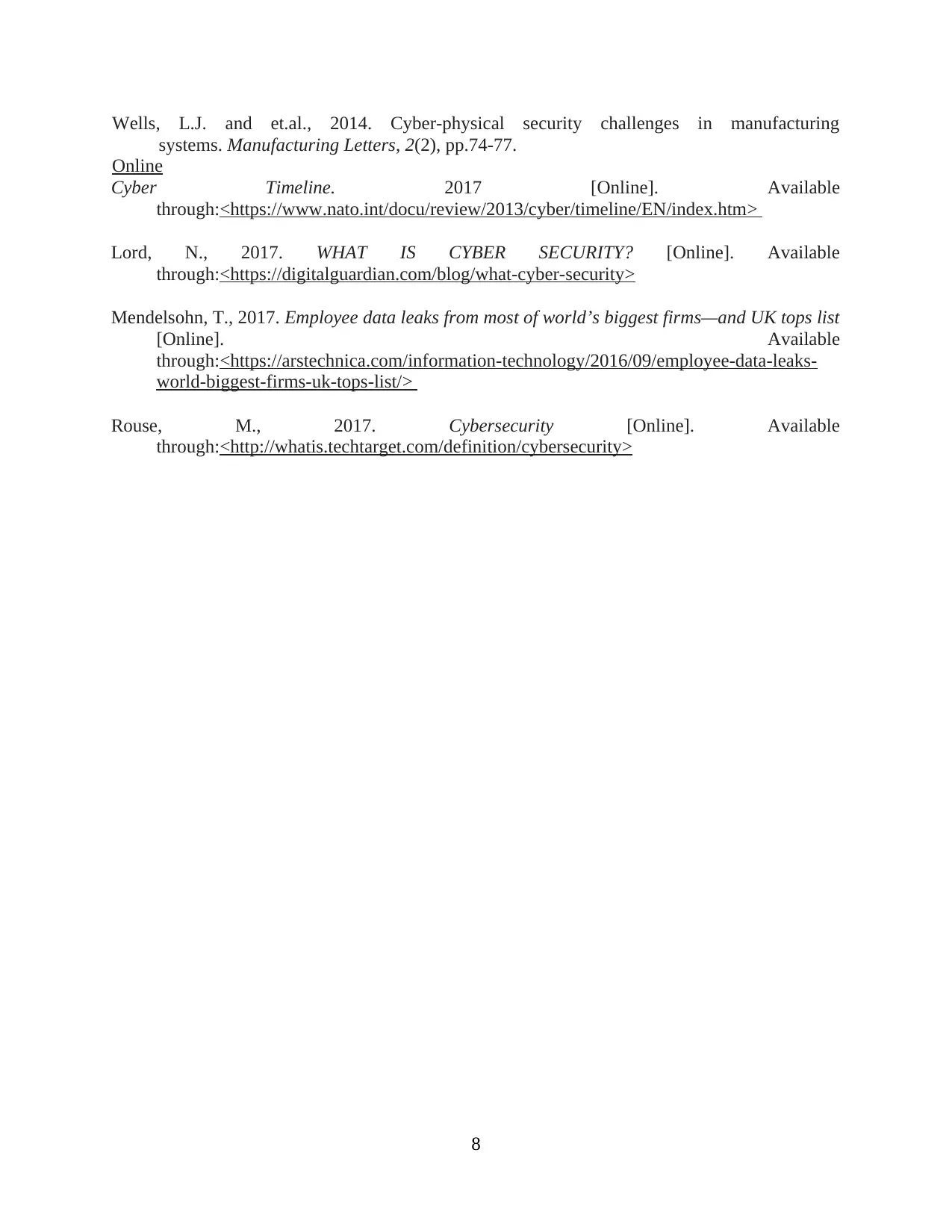
Wells, L.J. and et.al., 2014. Cyber-physical security challenges in manufacturing
systems. Manufacturing Letters, 2(2), pp.74-77.
Online
Cyber Timeline. 2017 [Online]. Available
through:<https://www.nato.int/docu/review/2013/cyber/timeline/EN/index.htm>
Lord, N., 2017. WHAT IS CYBER SECURITY? [Online]. Available
through:<https://digitalguardian.com/blog/what-cyber-security>
Mendelsohn, T., 2017. Employee data leaks from most of world’s biggest firms—and UK tops list
[Online]. Available
through:<https://arstechnica.com/information-technology/2016/09/employee-data-leaks-
world-biggest-firms-uk-tops-list/>
Rouse, M., 2017. Cybersecurity [Online]. Available
through:<http://whatis.techtarget.com/definition/cybersecurity>
8
systems. Manufacturing Letters, 2(2), pp.74-77.
Online
Cyber Timeline. 2017 [Online]. Available
through:<https://www.nato.int/docu/review/2013/cyber/timeline/EN/index.htm>
Lord, N., 2017. WHAT IS CYBER SECURITY? [Online]. Available
through:<https://digitalguardian.com/blog/what-cyber-security>
Mendelsohn, T., 2017. Employee data leaks from most of world’s biggest firms—and UK tops list
[Online]. Available
through:<https://arstechnica.com/information-technology/2016/09/employee-data-leaks-
world-biggest-firms-uk-tops-list/>
Rouse, M., 2017. Cybersecurity [Online]. Available
through:<http://whatis.techtarget.com/definition/cybersecurity>
8
⊘ This is a preview!⊘
Do you want full access?
Subscribe today to unlock all pages.

Trusted by 1+ million students worldwide
1 out of 9
Related Documents
Your All-in-One AI-Powered Toolkit for Academic Success.
+13062052269
info@desklib.com
Available 24*7 on WhatsApp / Email
![[object Object]](/_next/static/media/star-bottom.7253800d.svg)
Unlock your academic potential
Copyright © 2020–2025 A2Z Services. All Rights Reserved. Developed and managed by ZUCOL.





